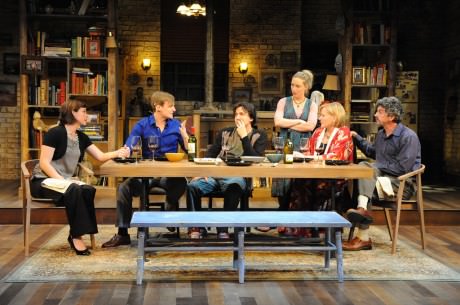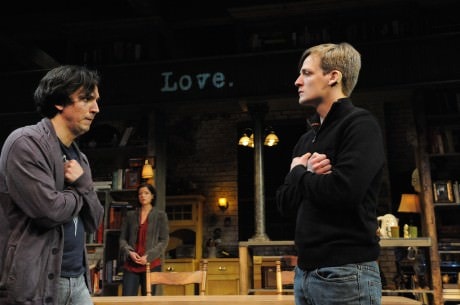Everyman Theatre closes their 2013/2014 season with British playwright Nina Raine’s gripping, heartwarming, coming-of-age story Tribes about a dysfunctional family and a young son who has struggled all his life to communicate within his family. Billy is deaf in a hearing family who has raised him to be hearing. He has never learned sign-language and has hearing aids but is never quite on top of all the arguments that his family is having. Meeting a woman who is on the brink of losing her own hearing unsettles the world that he has known thus far in his life and brings a whole new perspective of feelings and communication into play. Directed by the company’s Artistic Director Vincent M. Lancisi, this emotionally poignant struggle for self-identity— in a world where what it truly means to be understood can change drastically from person to person— will tug at your heartstrings, and show you that love can always be heard.

Director Vincent M. Lancisi explores the world of hearing and non-hearing with his combined use of intense lighting, sound, and projection designs. In order to make this an immersive experience for audience members all across the aural spectrum, the intricate workings of these visual and aural elements become an integral part of the plot and affect the emotional impact of the story immensely. Lighting Designer Jay A. Herzog working with Sound Designer Elisheba Ittoop, create a series of moments that occur mostly during the pauses between scenes that drive home the intensity of what it is like to be someone who hears, someone who is deaf, and someone who is going deaf.
Ittoop’s inclusion of classical music which as time progresses then blurs with static, buzzing, white noise and other garbled sounds tracks the progression of one of the character’s hearing loss. Entwining these moments with Herzog’s light work creates a unique audiovisual experience for the audience. The scene outside of the club with pulsating light that matches the rhythm of the subdued music from inside symbolizes how sound can be felt. Adding in designs from Projections Designer Erik Trester creates an additional dimension of emotions in these audiovisual moments. Trester’s work appears mostly during the scene changes where lines of music or brightly pulsing points of color appear on narrow screens set slightly above the set, but they augment the overall experience. Concepts like being able to visualize music become apparently clear with the addition of these projections.
Lancisi articulates a vision for this production both on and off the stage. Making the performance available and accessible to every audience member regardless of where they fall on the hearing spectrum has become an evolutionary process which now involves technology beyond compare. Hand-held closed captioning devices are available for those that wish them, with deflector screens so that they are personalized for each individual user. There are several sign-interpreted performances as well. Working with Director of Artistic Sign Language Willy Conley and Director of Access Tim MCarty, Lancisi has brought this incredible production to every audience member in the most accessible way possible.
The acting in the production is superb and the play itself is a well-crafted piece of emotionally stunning theatre. Lancisi has brought in deaf actor John McGinty to play Billy the one fully deaf character in the production, and his inclusion in the work showcases the rawer meaning behind the show’s subjects. McGinty gives a stupendous performance; emoting clearly in moments of speaking as well as signing and bringing many tears to my eyes and audience members throughout the production. His raw ability to translate emotions both with and without words is stunning and moving. Playing Billy, McGinty brings a level of authenticity to Nina Raine’s writing that would otherwise be lost in translation if the part were performed by a non-deaf actor.
The seamless inclusion of company members into the production is not only an Everyman hallmark but in this case a true triumph of language barriers as company member Megan Anderson takes on the role of Sylvia, a character who is going deaf and losing her hearing. The character is born to deaf parents but can hear until the genetic disorder that cost her parents their hearing begins to affect her. Anderson’s portrayal of this character is exceptional. The way her speech progressively changes to reflect the fact that she can no longer hear herself talk is both harrowingly realistic and deeply touching. It becomes a truly sorrowful journey to watch her character feeling the struggles of losing her identity that she has built around being a hearing person as she transitions into a person that can no longer hear. Andersons’ ability to fluidly express her emotions while using sign language is another feat of note; her vividly animated facial expressions carrying where her voice cannot in those moments of communication.
Anderson and McGinty share some of the most heartfelt moments in the production; truly uplifting and soul-searing moments that expose the vulnerability of their emotions both with and without words to one another and the audience. Some of the things communicated between these two actors’ characters in silence are the loudest sentiments echoed in the production. McGinty shares the other intensely emotional moments in the production with Alexander Strain, playing Billy’s brother Daniel. At first Strain’s character appears aloof and rather arrogant, the typical son with problems in a wholly dysfunctional family. But as the play progresses and his issues are unearthed, there is vulnerability that surfaces in Strain’s portrayal that makes him accessible both physically and emotionally.
Strain, once his character regresses into stammers and starts, gives an intensely epic performance, sharing moments with both Anderson and McGinty that shock, stun, and amaze the audience. It is the final moments of the play, shared between Strain and McGinty, that drive the play’s overall message of “love can always be heard” home hard.

With exceptional performances given by the three principles featured in this production, Tribes is a moving experience well worth-seeing and a perfect way for Everyman Theatre to close out its successful season.
Running Time: Approximately 2 hours and 15 minutes, with one intermission.
Tribes plays through June 22, 2014 at Everyman Theatre— 315 W. Fayette Street in Baltimore, MD. For tickets call the box office at (410) 752-2208, or purchase them online.




